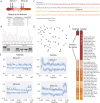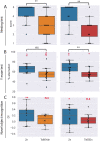Ts66Yah, a mouse model of Down syndrome with improved construct and face validity
- PMID: 36374158
- PMCID: PMC9789398
- DOI: 10.1242/dmm.049721
Ts66Yah, a mouse model of Down syndrome with improved construct and face validity
Abstract
Down syndrome (DS) is caused by trisomy of human chromosome 21 (Hsa21). The understanding of genotype-phenotype relationships, the identification of driver genes and various proofs of concept for therapeutics have benefited from mouse models. The premier model, named Ts(1716)65Dn/J (Ts65Dn), displayed phenotypes related to human DS features. It carries an additional minichromosome with the Mir155 to Zbtb21 region of mouse chromosome 16, homologous to Hsa21, encompassing around 90 genes, fused to the centromeric part of mouse chromosome 17 from Pisd-ps2/Scaf8 to Pde10a, containing 46 genes not related to Hsa21. Here, we report the investigation of a new model, Ts66Yah, generated by CRISPR/Cas9 without the genomic region unrelated to Hsa21 on the minichromosome. As expected, Ts66Yah replicated DS cognitive features. However, certain phenotypes related to increased activity, spatial learning and molecular signatures were changed, suggesting genetic interactions between the Mir155-Zbtb21 and Scaf8-Pde10a intervals. Thus, Ts66Yah mice have stronger construct and face validity than Ts65Dn mice for mimicking consequences of DS genetic overdosage. Furthermore, this study is the first to demonstrate genetic interactions between triplicated regions homologous to Hsa21 and others unrelated to Hsa21. This article has an associated First Person interview with the first author of the paper.
Keywords: Behavior and cognition; Gene dosage; Gene expression; Mouse model.
© 2022. Published by The Company of Biologists Ltd.
Conflict of interest statement
Competing interests The authors declare no competing or financial interests.
Figures







References
-
- Adams, D. C. and Otárola-Castillo, E. (2013). geomorph: an r package for the collection and analysis of geometric morphometric shape data. Methods Ecol. Evol. 4, 393-399. 10.1111/2041-210X.12035 - DOI
-
- Aït Yahya-Graison, E., Aubert, J., Dauphinot, L., Rivals, I., Prieur, M., Golfier, G., Rossier, J., Personnaz, L., Créau, N., Bléhaut, H.et al. (2007). Classification of human chromosome 21 gene-expression variations in Down syndrome: impact on disease phenotypes. Am. J. Hum. Genet. 81, 475-491. 10.1086/520000 - DOI - PMC - PubMed
Publication types
MeSH terms
Substances
LinkOut - more resources
Full Text Sources
Other Literature Sources
Medical
Molecular Biology Databases
Research Materials

